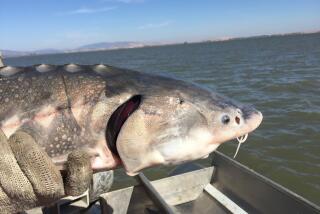White sturgeon
- Share via
[ACIPENSER TRANSMONTANUS]
Broad-bodied and sluggish, the massive white sturgeon is a reflection of the mighty rivers it inhabits. This ancient fish is covered with bizarre bony plates instead of scales and looks like a living fossil as it prowls deepwater shadows in search of invertebrates and fish. Using long feelers to sense prey, the sturgeon sucks in food like a vacuum cleaner when it opens its cavernous mouth. It migrates between salt and fresh water, but unlike salmon, it makes this journey many times and can live up to 100 years. Reproductive adults, prompted by heavy runoff each spring, move upstream from brackish estuaries to spawn in deep freshwater streams. Females won’t make this arduous journey until they are 15 to 30 years old. They make the trip carrying up to 200 pounds of eggs (highly prized caviar) and wait several years before spawning again to replenish their energy.
NATURAL HISTORY
Once extremely abundant on the Pacific Coast, white sturgeon now survive only in the three largest rivers -- Sacramento, Columbia and Fraser -- after being hunted to the brink of extinction. Its recovery is hindered by dams that prevent access to ancestral migration routes and spawning grounds.
KEY CHARACTERISTICS
Characterized by strange armor-like projections and a long snout tipped with fleshy whiskers. A hundred years ago, full-grown adults could exceed 1,400 pounds and 20 feet in length. Today they are generally smaller, possibly because they no longer have full access to a range of feeding grounds.
More to Read
Sign up for Essential California
The most important California stories and recommendations in your inbox every morning.
You may occasionally receive promotional content from the Los Angeles Times.













